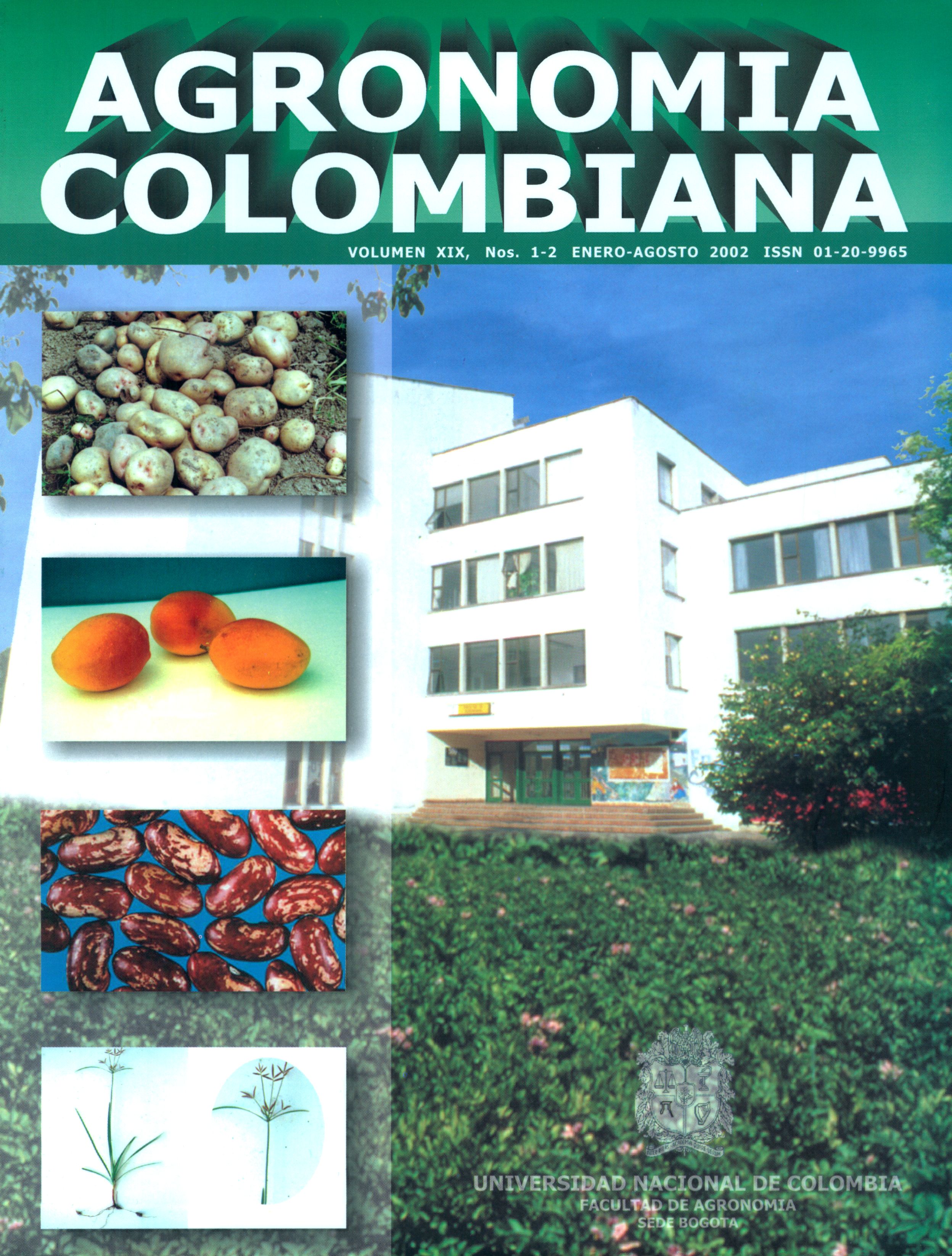Respuesta al glifosato de un aislamiento de Rhizoctonia solani agente causal del anublo de la vaina del arroz, y de cuatro aislamientos de Trichoderma, bajo condiciones in vitro
In vitro response of one isolate of Rhizoctonia solani, the pathogen of the rice sheath blight and four isolates of Trichoderma to glyphosate
Keywords:
epidemiología, herbicidas, hongos fitopatógenos (es)epidemiology, herbicides, fungal plant pathogens (en)
Downloads
causó la mayor inhibición del crecimiento del hongo fue
de 2500 mg/L. Por otra parte, no se encontró que el glifosato
estimulara el crecimiento de R. solani. En teoría, en una aplicación comercial de glifosato de 1,5 Kg ia/ha y asperjando directamente al suelo sin vegetación, el glifosato en el suelo estaría a una concentración de 0,75 mg/Kg de suelo (suponiendo que la capa arable de una hectárea de suelo pesa 2.000.000 de Kg); por tanto, la concentración de glifosato después de una aplicación comercial, está muy por debajo de la concentración a la cual se inicia la reducción del crecimiento de R. solani. Por su parte, la respuesta de Trichoderma al glifosato fue similar a la de R. solani; además, se encontró que el glifosato no afecta la capacidad antagonista de Trichoderma sobre R. sotaní. Estos resultados no apoyan la hipótesis que el glifosato, bajo las condiciones de uso en cultivos de arroz para el control de las malezas, estuviera afectando el crecimiento de R. solani o de su antagonista Trichoderma. Una posible relación entre el uso intensivo del herbicida y la incidencia del añublo de la vaina del arroz, debería investigarse en términos de supervivencia
y germinación de esclerocios del patógeno.
blight of rice (Orysa saliva L.), one of the most important
rice diseases in Colombia. G1yphosate (N-phosphonomethyl
glicine acid) is sprayed in rice fields as a preplant herbicide, specially aimed at red rice (O. saliva). Preliminary field observations in Tolima, Colombia suggested a relationship between intensive use of glyphosate and sheath blight incidence. Thus, the present study was undertaken to shed light on the effect of glyphosate on R. solani and Thrichoderma sp., a.putative antagonist, under laboratory conditions. The effect of the herbicide was assessed on the growth ofR. solani in summerged culture and solid media and of Thrichoderma on solid media. R. sotaní withstood up to 300 mg L-! without expressing reduction in growth, Increasing concentrations of the herbicide caused growth reduction, and the detrimental effect reached a plateau at 2500 mg L-1. Rhizoctonia growth was not enhanced at any herbicide concentration. The expected concentration of glyphosate in the soil after spraying at commercial dosages would be O, 75 mg Kg', which is well below the observed in vitro threshold. The response of Thrichoderma was similar to that of R. sotaní. Glyphosate did not affect the antagonistic ability of Thrichoderma against R. solani. These results do not support the view that glyphosate, as an herbicide treatment in rice
field, may affect in any way the population densities of R.
sotaní or its antagonist Thrichoderma sp. Therefore, the
postulated connection between intensive herbicide use
and increased sheath blight incidence is not substantiated
on mycelial growth alone. This relationship should be
explored in terms of selerotial survival and germination.
How to Cite
APA
ACM
ACS
ABNT
Chicago
Harvard
IEEE
MLA
Turabian
Vancouver
Download Citation
Article abstract page views
Downloads
License
Copyright (c) 2002 Agronomía Colombiana

This work is licensed under a Creative Commons Attribution-NonCommercial-ShareAlike 4.0 International License.
© Centro Editorial de la Facultad de Ciencias Agrarias, Universidad Nacional de Colombia
Reproduction and quotation of material appearing in the journal is authorized provided the following are explicitly indicated: journal name, author(s) name, year, volume, issue and pages of the source. The ideas and observations recorded by the authors are their own and do not necessarily represent the views and policies of the Universidad Nacional de Colombia. Mention of products or commercial firms in the journal does not constitute a recommendation or endorsement on the part of the Universidad Nacional de Colombia; furthermore, the use of such products should comply with the product label recommendations.
The Creative Commons license used by Agronomia Colombiana journal is: Attribution - NonCommercial - ShareAlike (by-nc-sa)

Agronomia Colombiana by Centro Editorial of Facultad de Ciencias Agrarias, Universidad Nacional de Colombia is licensed under a Creative Commons Reconocimiento-NoComercial-CompartirIgual 4.0 Internacional License.
Creado a partir de la obra en http://revistas.unal.edu.co/index.php/agrocol/.




















